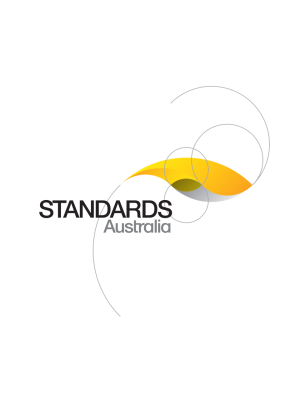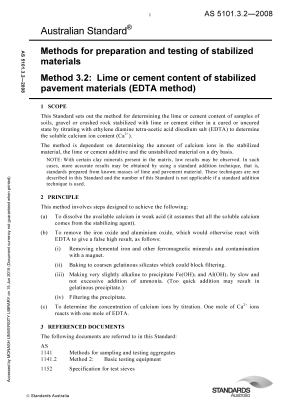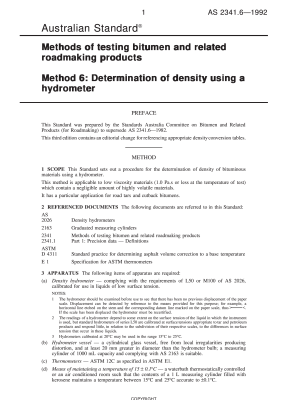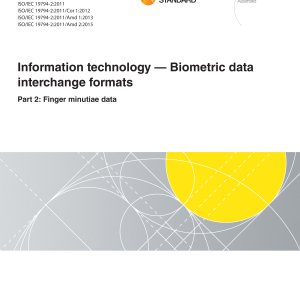🔍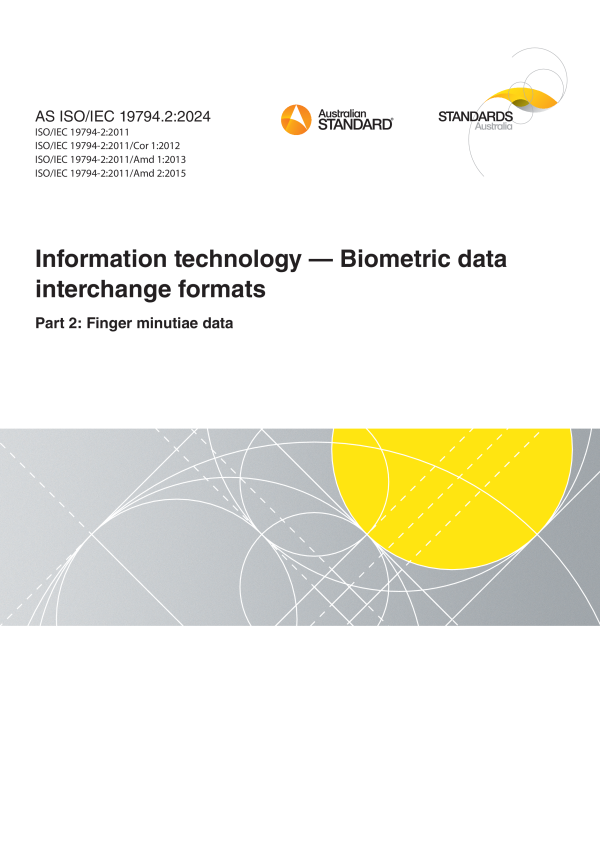

Purchase the full subscription package now and enjoy a 40% discount, along with free updates for future editions.
AS ISO/IEC 19794.2:2024
$193.66
Information technology – Biometric data interchange formats, Part 2: Finger minutiae data
AS ISO/IEC 19794.2:2024 identically adopts ISO/IEC 19794 2:2011, which specifies a concept and data formats for representation of fingerprints using the fundamental notion of minutiae.
Table of contents
Header
About this publication
Preface
Foreword
Introduction
1 Scope
2 Conformance
3 Normative references
4 Terms and definitions
5 Abbreviated terms
6 Minutiae extraction
6.1 Purpose
6.2 Minutia description
6.3 Minutia type
6.3.1 General
6.3.2 Unique minutia
6.3.3 Encoding trifurcations
6.4 Minutia location
6.4.1 General
6.4.2 Coordinate system
6.4.3 Minutia placement on a ridge ending (encoded as valley skeleton bifurcation point)
6.4.4 Minutia placement on a ridge bifurcation (encoded as a ridge skeleton bifurcation point)
6.4.5 Minutia placement on a ridge skeleton endpoint
6.4.6 Usage of the minutia placement by the record and on-card biometric comparison formats
6.5 Minutiae direction
6.5.1 Angle conventions
6.5.2 Minutia direction of a ridge ending (encoded as valley skeleton bifurcation point)
6.5.3 Minutia direction of a ridge bifurcation (encoded as ridge skeleton bifurcation point)
6.5.4 Minutia direction of a ridge skeleton end point
6.6 Core and delta placement
6.7 Encoding of multibyte quantities
7 Finger minutiae format types
7.1 Overview
7.2 Record format
7.3 On-card comparison format
8 Finger minutiae record format
8.1 Introduction
8.2 Record organization
8.3 General header
8.3.1 Format identifier
8.3.2 Version number
8.3.3 Length of record
8.3.4 Number of finger representations
8.3.5 Device certification block flag
8.4 Finger minutiae representation format
8.4.1 Finger minutiae representation header
8.4.2 Representation length
8.4.3 Capture date-time
8.4.4 Capture device technology ID
8.4.5 Capture device vendor identifier
8.4.6 Capture device type identifier
8.4.7 Finger image quality
8.4.7.1 General
8.4.7.2 Number of quality Blocks
8.4.7.3 Quality score
8.4.7.4 Quality algorithm vendor ID
8.4.7.5 Quality algorithm ID
8.4.8 Capture device certifications
8.4.8.1 General
8.4.8.2 Number of certifications
8.4.8.3 Certification authority identifier
8.4.8.4 Certification scheme identifier
8.4.9 Finger position
8.4.10 Representation number
8.4.11 Image spatial sampling rate (horizontal)
8.4.12 Image spatial sampling rate (vertical)
8.4.13 Impression type
8.4.14 Size of scanned image in X-direction
8.4.15 Size of scanned image in Y-direction
8.4.16 Minutia field length
8.4.17 Ridge ending type
8.4.18 Number of minutiae
8.4.19 Finger minutiae data
8.4.19.1 Qualified finger minutia pixel record format
8.4.19.1.1 Overview
8.4.19.1.2 Minutia type
8.4.19.1.3 Minutia position
8.4.19.1.4 Minutia angle
8.4.19.1.5 Minutia quality
8.4.19.2 Finger minutia pixel record format
8.4.19.2.1 Overview
8.4.19.2.2 Minutia type, position, and angle
8.5 Extended data
8.5.1 Common extended data fields
8.5.1.1 Extended data block length
8.5.1.2 Extended data area type code
8.5.1.3 Extended data area length
8.5.1.4 Data section
8.5.2 Ridge count data format
8.5.2.1 Ridge count extraction method
8.5.2.1.1 Eight-neighbour ridge count extraction method
8.5.2.1.2 Four- neighbour ridge count extraction method
8.5.2.2 Ridge Count Data
8.5.2.3 Ridge count format summary
8.5.3 Core and delta data format
8.5.3.1 General
8.5.3.2 Core information
8.5.3.2.1 Number of cores
8.5.3.2.2 Core information type
8.5.3.2.3 Core position
8.5.3.2.4 Core angle
8.5.3.3 Delta information
8.5.3.3.1 Number of deltas
8.5.3.3.2 Delta information type
8.5.3.3.3 Delta position
8.5.3.3.4 Delta angles
8.5.3.4 Core and delta format summary
8.5.4 Zonal quality data
8.5.4.1 General
8.5.4.2 Zonal quality vendor ID
8.5.4.3 Zonal quality algorithm ID
8.5.4.4 Cell width and height
8.5.4.5 Cell quality information depth
8.5.4.6 Cell quality data
8.5.4.7 Zonal quality data format summary
9 Finger minutiae on-card comparison format
9.1 Purpose
9.2 On-card comparison format
9.2.1 Minutia placement
9.2.2 Encoding
9.2.3 Minutia position
9.2.4 Minutia type
9.2.5 Minutia angle
9.3 Number of minutiae and truncation
9.3.1 General aspects
9.3.2 Removing minutiae for card processing
9.3.3 Lack of minutiae
9.3.4 Biometric comparison algorithm parameters
9.3.5 Number of minutiae
9.4 Minutiae order
9.4.1 Data object for minutiae ordering
9.4.2 Ordered ascending
9.4.3 Ordered descending
9.4.4 Cartesian X-Y
9.4.5 Cartesian Y-X
9.4.6 Angle
9.4.7 Polar
9.4.8 X or Y Coordinate extension
9.5 Usage of extended data for the on-card comparison format
9.5.1 Data objects for extended data
9.5.2 Zonal quality data modified for on-card comparison minutiae formats
9.5.2.1 Zonal quality data format summary
9.5.2.2 Density of cells in the quality map
9.5.2.3 Quality map width and height
9.5.2.4 Cell quality information depth
9.5.2.5 Cell quality data
9.5.3 Indication of card capabilities
10 Registered format type identifiers
Annex A
A.1 Overview
Annex B
B.1 Overall record format
B.2 General header format
B.3 Finger minutiae representation format
B.4 Qualified finger minutiae pixel record
B.5 Finger minutiae pixel record
B.6 Extended data
Annex C
C.1 Data
C.2 Example data format diagrams
C.3 Raw data for the resulting minutiae record
Annex D
D.1 Enrolment
D.1.1 Number of minutiae
D.1.2 Number of required finger presentations
D.2 Comparison
D.2.1 Comparison conditions
D.2.2 Retry Counter
D.3 Security aspects of finger minutiae presentation to the card
Annex E
E.1 Image quality specification for AFIS systems
E.1.1 General
E.1.2 Fingerprint scanner
E.1.2.1 Linearity
E.1.2.1.1 Requirement
E.1.2.1.2 Background
E.1.2.2 Geometric accuracy
E.1.2.2.1 Requirement (across-bar)
E.1.2.2.2 Requirement (along-bar)
E.1.2.2.3 Background
E.1.2.3 Spatial frequency response
E.1.2.3.1 Requirements
E.1.2.3.2 Background
E.1.2.4 Signal-to-noise ratio
E.1.2.4.1 Requirement
E.1.2.4.2 Background
E.1.2.5 Gray-level uniformity
E.1.2.5.1 Requirement – adjacent row, column uniformity
E.1.2.5.2 Requirement – pixel-to-pixel uniformity
E.1.2.5.3 Requirement – small area uniformity
E.1.2.5.4 Background
E.1.2.6 Fingerprint image quality
E.1.2.6.1 Requirement – Fingerprint gray range
E.1.2.6.2 Background
E.1.2.6.3 Requirement – Fingerprint artifacts and anomalies
E.1.2.6.4 Background
E.1.2.6.5 Requirement – Fingerprint sharpness & detail rendition
E.1.2.6.6 Background
E.1.3 Identification flats
E.1.3.1 Requirement – Capture protocol
E.1.3.2 Background
E.1.3.3 Requirement – Verifiable finger sequence data
E.1.3.4 Background
E.2 Image quality specification for personal verification
E.2.1 General
E.2.2 Requirements
E.2.2.1 Geometric accuracy
E.2.2.1.1 Requirement #1 (across-bar)
E.2.2.1.2 Requirement #2 (along-bar)
E.2.2.1.3 Background
E.2.2.2 Spatial frequency response (SFR)
E.2.2.2.1 Requirements
E.2.2.2.2 Background
E.2.2.3 Gray-level uniformity
E.2.2.3.1 Requirement #1 – adjacent row, column uniformity
E.2.2.3.2 Requirement #2 – pixel to pixel uniformity
E.2.2.3.3 Requirement #3- small area uniformity
E.2.2.3.4 Requirement #4 – Noise
E.2.2.3.5 Background
E.2.2.4 Fingerprint image quality
E.2.2.4.1 Requirement #1 – Fingerprint Gray Range
E.2.2.4.2 Background
E.2.2.4.3 Requirement #2 – Fingerprint Artifacts and Anomalies
E.2.2.4.4 Background
E.2.2.4.5 Requirement #3 – Fingerprint Sharpness & Detail Rendition
E.2.2.4.6 Background:
E.3 Requirements and test procedures for optical fingerprint scanners
E.3.1 Introduction
E.3.2 Testing prerequisites
E.3.2.1 Requirements on the testing laboratory
E.3.2.2 Requirements on the test object
E.3.2.3 Requirements on the evaluation software
E.3.2.4 Demands on the test targets
E.3.2.4.1 Test targets for optical fingerprint scanner working on the principle of frustrated total internal reflection in the bright field
E.3.2.4.2 Test targets for optical fingerprint scanner working on the principle of frustrated total internal reflection in the dark field
E.3.3 Requirements and test procedures
E.3.3.1 Investigation of the grayscale linearity
E.3.3.1.1 Requirements
E.3.3.1.2 Background
E.3.3.1.3 Used targets
E.3.3.1.3.1 Test targets for optical fingerprint scanner working on the principle of frustrated total internal reflection in the bright field
E.3.3.1.3.2 Test targets for optical fingerprint scanner working on the principle of frustrated total internal reflection in the dark field
E.3.3.1.4 Test procedure
E.3.3.1.4.1 Test step 1
E.3.3.1.4.2 Test step 2
E.3.3.1.4.3 Test step 3
E.3.3.1.5 Requirement compliance
E.3.3.2 Investigation of the spatial sampling rate and geometrical accuracy
E.3.3.2.1 Requirements
E.3.3.2.2 Background
E.3.3.2.3 Used targets
E.3.3.2.3.1 Test targets for optical fingerprint scanner working on the principle of frustrated total internal reflection in the bright field
E.3.3.2.3.2 Test targets for optical fingerprint scanner working on the principle of frustrated total internal reflection in the dark field
E.3.3.2.4 Test procedure
E.3.3.2.4.1 Test step 1
E.3.3.2.4.2 Test step 2
E.3.3.2.4.3 Test step 3
E.3.3.2.5 Requirement compliance
E.3.3.3 Investigation of the contrast transfer function
E.3.3.3.1 Requirements
E.3.3.3.2 Background
E.3.3.3.3 Used targets
E.3.3.3.3.1 Test targets for optical fingerprint scanner working on the principle of frustrated total internal reflection in the bright field
E.3.3.3.3.2 Test targets for optical fingerprint scanner working on the principle of frustrated total internal reflection in the dark field
E.3.3.3.4 Test procedure
E.3.3.3.4.1 Test step 1
E.3.3.3.4.2 Test step 2
E.3.3.3.4.3 Test step 3
E.3.3.3.5 Requirement compliance
E.3.3.4 Investigation of the signal-to-noise ratio and the gray-level uniformity
E.3.3.4.1 Requirements
E.3.3.4.2 Background
E.3.3.4.3 Used targets
E.3.3.4.3.1 Test targets for optical fingerprint scanner working on the principle of frustrated total internal reflection in the bright field
E.3.3.4.3.2 Test targets for optical fingerprint scanner working on the principle of frustrated total internal reflection in the dark field
E.3.3.4.4 Test procedure
E.3.3.4.4.1 Test step 1
E.3.3.4.4.2 Test step 2
E.3.3.4.5 Requirement compliance
E.3.3.5 Investigation of the gray scale range of fingerprint images
E.3.3.5.1 Requirements
E.3.3.5.2 Background
E.3.3.5.3 Used targets
E.3.3.5.4 Test procedure
E.3.3.5.4.1 Test step 1
E.3.3.5.4.2 Test step 2
E.3.3.5.5 Requirement compliance
Annex F
F.1 General
F.2 Terms and definitions
F.3 Minutiae detection strategy
F.3.1 “Liberal-conservative” spectrum
F.3.2 Fingerprint boundary
F.3.3 Sweat pore
F.3.4 Touching ridges
F.3.5 Incipient ridge
F.3.6 Crease
F.3.7 Core
F.3.8 Delta
F.4 Minutia characteristics
F.4.1 Rationale
F.4.2 Minutia type
F.4.3 Minutia location tools
F.4.3.1 Consideration of the spatial sampling rate of the underlying finger image
F.4.3.2 Image binarisation
F.4.3.3 Image skeletonization
F.4.3.4 Ridge flow direction
F.4.4 Ridge gradient method
F.4.4.1 Minutia location at a ridge skeleton endpoint
F.4.4.2 Minutia location at a ridge skeleton bifurcation point
F.4.4.3 Minutia location at a valley skeleton bifurcation point
F.4.4.4 Minutia direction at a ridge skeleton endpoint
F.4.4.5 Minutia direction at a ridge skeleton bifurcation point
F.4.4.6 Minutia direction at a valley skeleton bifurcation point
F.4.5 Valley skeletal bifurcation method
F.4.5.1 Minutia location at a valley skeleton bifurcation
F.4.5.2 Minutia location at a ridge skeleton bifurcation
F.4.5.3 Angle of a ridge ending
F.4.5.4 Angle of a ridge bifurcation
F.4.6 Minutia quality
F.5 Sample image
Bibliography
Amendment 1
Amendment 1: Conformance testing methodology and clarification of defects
Amendment 2
Corrigendum 1
Cited references in this standard
Content history
[Current]
[Current]
[Current]
[Superseded]
AS ISO/IEC 19794.2-2007 REC:2017
view more
Please select a variation to view its description.
| Published | 06/09/2024 |
|---|---|
| Pages | 136 |
Please select a variation to view its pdf.

